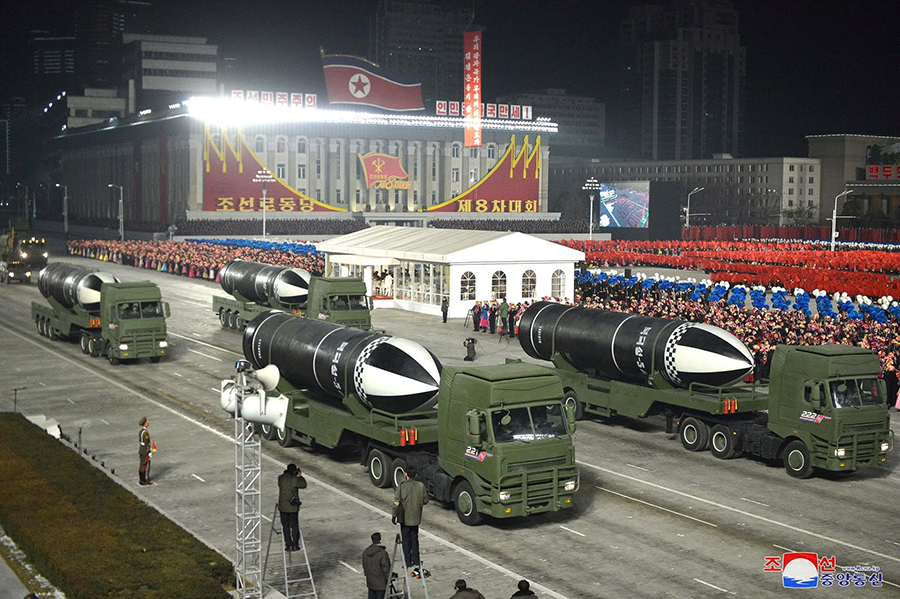North Korea Displays New Missiles
March 2021
By Julia Masterson
North Korea unveiled a new submarine-launched ballistic missile (SLBM) and a host of other missiles at its annual military parade on Jan. 14. The display of military hardware came only three days after the conclusion of the 8th Congress of the Worker’s Party of Korea, during which North Korean leader Kim Jong Un pledged to “further strengthen the nuclear war deterrent while doing our best to build up the most powerful military strength.”
 The display of North Korean ballistic missile technology comes as the incoming administration of U.S. President Joe Biden begins a review of U.S. policy regarding North Korea.
The display of North Korean ballistic missile technology comes as the incoming administration of U.S. President Joe Biden begins a review of U.S. policy regarding North Korea.
North Korea’s new SLBM, dubbed the Pukguksong-5, bears structural similarities to the nuclear-capable Pukguksong-4 and Pukguksong-3 SLBMs, which were unveiled in 2020 and 2019, respectively. According to Michael Elleman, director for nonproliferation and nuclear policy at the International Institute for Strategic Studies and a leading expert on North Korea’s missiles, “These dimensional similarities indicate North Korea is still in the process of settling on a specific design for its next-generation SLBM.”
Elleman suggested in a Jan. 15 analysis for the website 38 North that he believes the Pukguksong-5 “remains on the drawing board.” The Pukguksong-5 is not known to have been tested, so its exact capabilities and specifications remain unclear. Elleman also noted indicators that suggest the Pukguksong-5 could be solid-fueled, based on its structural design.
North Korean state media published on Jan. 15 called the Pukguksong-5 “the world’s most powerful weapon.”
The Jan. 14 parade in Pyongyang also featured several short-range tactical missiles, including one that appears to have solid-fueled rocket motors. North Korea already boasts solid-fueled missiles, but ongoing development of those systems is demonstrative of North Korea’s progress toward refining that capability. Solid-fueled missiles are generally considered to be more strategic than liquid-fueled missiles because solid-fueled systems can be stored together and can be mobilized or launched in a shorter period of time.
North Korea did not reveal any new intercontinental ballistic missiles (ICBMs) at the January military parade. North Korea remains committed to the development of a robust missile capability and appears focused on achieving a sea-based component of its nuclear arsenal.
In his report before the Congress of the Worker’s Party of Korea, which was held Jan. 5–12, Kim noted that North Korea’s national defense science sector is in the process of conducting research and perfecting a “new nuclear-powered submarine” and “an underwater-launch nuclear strategic weapon.” Although undoubtedly significant, these systems will take several years to complete and require extensive testing that would likely not go unnoticed by the international community.
In his report to the Congress, Kim further elaborated on his country’s progress toward building a reliable nuclear deterrent and a strong military. He highlighted developments in technology and noted steps undertaken to “miniaturize, lighten, and standardize nuclear weapons and to make them tactical ones.” He also remarked on the success of North Korea’s Nov. 29, 2017, test of its Hwasong-15 ICBM, which “declared with pride to the world the accomplishment of the historic cause of building the national nuclear force and the cause of building a rocket power.” (See ACT, January/February 2018.)
Kim also noted that North Korea’s national defense science sector succeeded in developing a “super large” multiple-launch rocket system, as well as “ultra-modern tactical nuclear weapons including new-type tactical rockets” and intermediate-range cruise missiles. He said, “This enabled us to gain a reliable edge in military technology.”
Kim was promoted to the rank of general secretary during the congress on Jan. 11. That title had remained vacant for the nine years after Kim’s father, Kim Jong Il, died in 2011.
Between Kim’s remarks at the meeting of the Worker’s Party of Korea and the weapons displayed at the military parade, it is clear that North Korea’s capabilities are becoming increasingly sophisticated. Revelation of a next-generation SLBM suggests a test launch of that system could happen in the near future.
Kim also briefly remarked on relations with the United States in his report to the congress and stated that the “real intention” of U.S. policy toward North Korea “would never change,” regardless of who was in office. He named the United States as North Korea’s “principal enemy.”
It remains to be seen how Biden and his administration will approach the North Korea portfolio. The administration has given little indication of its diplomatic posture toward Pyongyang, but Secretary of State Antony Blinken announced on Jan. 19 that the administration intended to conduct a full review of U.S. policy toward North Korea once in office.
Close U.S. allies have expressed hope that Biden will continue denuclearization talks with North Korea. Notably, South Korean President Moon Jae-in said on Jan.18 that he believes Pyongyang seeks a security guarantee from the United States, in addition to normalized relations—two principles already agreed to at the summit between Kim and President Donald Trump in Singapore in June 2018. During a New Year’s press conference, Moon also stated his personal view that Kim “clearly has a will towards peace, dialogue, and denuclearization.”
EDITOR’S NOTE: Michael Elleman succumbed to cancer and died on Feb. 20. For more on his life and work, see the April 2021 issue of Arms Control Today.
